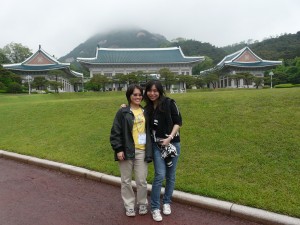by Prise Ho Pei Fang, Sociology, Year 2 and Lee Jia En, Geography, Year 2

Annyeonghaseyo? (Hello!)
The memories of last spring are still deeply etched in our minds when we were awarded scholarships from the National Institute for International Education Development (NIIED) for an 11-day programme to Korea. There, we experienced many different aspects of the Korean culture and also forged lifelong friendships with the other participants from all around Asia.
It seems an impossible feat to pick just one favourite part of the trip as each and every part is equally precious and unforgettable. We especially enjoyed the interaction between the participants and the supervisors. Having spent every waking moment in each others’ company for 11 days, we learned a lot about each other’s quirks and truly grew close to each other.
Visiting Seorak Mountain was a breathtaking experience. At the peak of the mountain, we experienced the picturesque scenery through the peaceful calm of the Korean morning to the chilly afternoon was awe-inspiring. We spent quite a while on the mountain, simply soaking in the euphoria and taking many pictures in hope to catch the splendour and bring back part of it with us. One fond memory was eating piping Tokbukki, a rice cake snack, in the chilly weather of the high altitudes.
Homestay was yet another part of the trip that left us with timeless memories. It was raining when we arrived but the cold immediately dissipated as our host family welcomed us with open arms and warm hugs. We were enveloped in the warmth of family as we sat in the living room drinking soju, eating snacks and kimchi, and chatting with one another. Despite the short three day stay, it already felt as if we were part of their family.
There are so many parts of the trip that we fondly remember, each important in piecing together the memorable spring in Korea. The stately Cheongwadae (Presidential Palace), heart-stopping beauty of the lake we cycled past on our bicycle tour in Gyeong Ju, the heat from the steel rods at POSCO, the reverberation of the drumbeats through our bodies during the Nanta show, the rows of neatly parked cars waiting to be shipped at the Hyundai shipping yard, the mouth-watering Dakgalbi we ate for dinner at Chun Cheon on our first night there, the smell of freshly cooked Hoddeok that we had at a rest stop on our way from visiting Naksansa Temple, romantic walks beneath endless rows of pine trees in Nami Island, the lectures at the hosting universities, and the sheer smiles after eating Baskin Robbins on a hot Seoul day along Cheonggyecheon – these are all things that will continue to inspire us .
The trip gave us an opportunity to get to experience and learn more about Korea firsthand and where the Korean language which we learn in school came alive through Korean culture and traditions. The cultural aspect from this trip complemented our knowledge of Korea gained through the K-wave, thus giving us a holistic and memorable experience to dynamic Korea.
Kamsahamnida. (Thank you.)

Prise Ho and Lee Jia En are reading Korean 2 at the Centre of Language Studies, FASS and have been awarded scholarships by the National Institute for International Education (NIIED). The Korean government organisation is affiliated with the Ministry of Education, Science and Technology and aims to develop and foster human resources in the age of globalisation. It awards scholarships to international students to give them an opportunity to know more Korean culture and society through the programme. The scholarships will cover all expenses for the students in Korea.
They participated in the programme from 11 to 21 May 2009 and visited cultural and industrial sites, and Korean universities. They also experienced staying with a Korean family (home stay).
